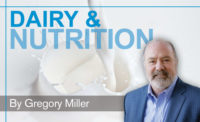A peek at a best-seller list or a trip to the local bookstore reveals a plethora of books on aging. Their prevalence reflects considerable interest in longevity and healthy aging during a unique time in our country’s history. The U.S. population is older than it has ever been.
According to the U.S. Census Bureau, the median age in the United States was 38.2 in 2022, which is a record high. Additionally, the bureau reports the number of persons ages 65 and older will reach 80.8 million by 2040 (up from 54.1 million in 2019), and the 85-and-older population is projected to more than double to 14.4 million by 2040 (up from 6.6 million in 2019).
A growing population of aging adults will have significant impacts on many, if not all, facets of American life, including the health care environment, economy, consumer landscape, and family dynamics. At the same time, opportunities for dairy foods are presenting themselves as the “Food is Medicine” philosophy and resulting programs move into the mainstream, catching the attention, action, and dollars of the public health and health care community, food policy advocates and more. In addition, emerging research demonstrates the benefits of dairy foods across the lifespan, including with older adults.
“Food is Medicine” programs pose opportunity
At its core, Food is Medicine advocates see a connection between diet and disease treatment, management and prevention. Interventions are evolving and include everything from community pilot projects to public health programs and for-profit investments that provide healthy food or nutrition prescriptions as part of intervention plans.
The 2022 White House Conference on Hunger, Nutrition, and Health highlighted Food is Medicine as a key strategy. More recently, the federal government invested $59.4 million into produce prescriptions and nutrition incentive programs and announced Medicaid benefits may soon be spent on certain food programs.
The Rockefeller Foundation and the American Heart Association are mobilizing $250 million to build a national initiative to increase the understanding and use of Food is Medicine programs and make them part of the health care system. In the private sector, the Kroger Co., the largest supermarket operator by revenue in the United States, is responding through a Food is Medicine platform that features telenutrition with registered dietitian nutritionists and curated healthy food boxes.
Food is Medicine interventions can support healthy aging with a variety of curated foods, including dairy, that are culturally relevant, nutrient dense, and shown to benefit older adults.
Dairy foods can help manage disease, maintain quality of life
Most older adults have at least one chronic health condition and are at increased risks related to cognition. In addition, the growth of the older adult population may contribute to a rapid rise in type 2 diabetes cases, as well as millions of older cancer patients.
At the same time, emerging research is showing positive impacts of dairy foods on numerous conditions:
- Chronic diseases: Older adults have unique nutritional needs that support optimal health and enhance quality of life for healthy aging. Research shows milk and yogurt reduce the risk for obesity and inflammation, which are connected to chronic diseases. In addition, low-fat dairy foods and milk reduce risk for hypertension, while yogurt reduces risk for type 2 diabetes.
- Bone and muscle: Older adults are at greater risk for health conditions related to bone and muscle mass loss, including osteoporosis and sarcopenia. One study published in The British Medical Journal found that nursing home residents who increased their intake of milk, yogurt, and cheese from an average of two servings per day to three and a half servings per day demonstrated a 33% reduction in all fractures after just six months and a 46% reduction in hip fractures, as well as an 11% reduction in falls. Nutrient-rich dairy foods also provide high-quality protein to help maintain muscle, as well as bone-building nutrients important during bone remodeling that takes place post-menopause.
- Cognition: Newly published research investigated the association between dairy intake and risk of incident dementia in older adults and found that daily yogurt consumers had a reduced risk for dementia and that yogurt intake might be inversely associated with dementia risk. Overall, evidence suggests that dietary patterns with higher variety may reduce the risk of dementia in older adults. However, more high-quality research is needed.
Interest in the changing needs of older populations isn’t going away anytime soon. By working together to educate the public and private sectors — including policymakers, the health care community, and consumers — dairy advocates can help elevate the health of older populations and maintain dairy foods’ position as an essential part of daily healthy eating patterns.
Note: Societal impacts of the growing aging population were recently included in the Dairy Council of California Trends report. To read about this and other trending topics, visit dairycounilofca.org/trends




